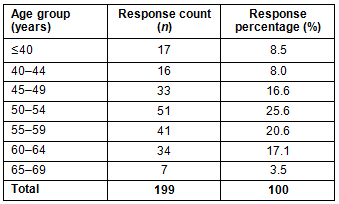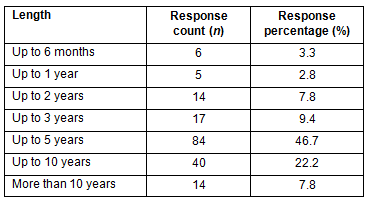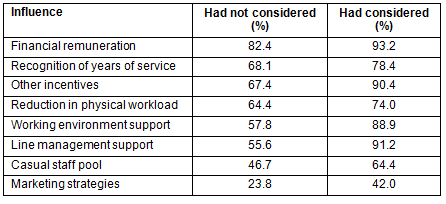The purpose of this article is to provide an enhanced understanding of the retirement plans and post-retirement employment intentions of nurses and midwives living and working in the Northern Territory of Australia. The study identified differences between those who would and those who would not consider working 'post-retirement'.
The Northern Territory (NT) nursing and midwifery sectors have long been struggling to deal with workforce issues such as high rates of workforce turnover, unusually high numbers of contract workers (many of them employed by nursing agencies), large numbers of internationally qualified nurses and midwives, and an ageing of the workforce1,2.
This is due to the unusual context for nursing practice in the NT when compared with Australia as a whole. Its remoteness, small local population (approximately 220 000 people, of which 30.0% are Indigenous), and isolation from major educational institutions has led to a workforce that is largely recruited from outside the jurisdiction. At the same time, there is a group of long-term residents, many of whom moved to the NT in the 1970s and 1980s, that is now nearing retirement age1.
Approximately 31.0% of the current nursing and midwifery workforce in the NT is aged 50 and over3. Many of these nurses and midwives have spent most of their professional careers in remote or very remote jurisdictions, and have gained significant remote area nursing knowledge1.
While increasing flexibility (ie flexibility of hours) is becoming common in the nursing workforce globally, current policies in the NT continue to focus on the engagement of full-time, recently-qualified nurses and midwives. With a compulsory retirement age of 65 due to legislative requirements, there are currently no policies in place to support the continuing engagement of older nurses1,4.
Research by Martel5 suggests that a large proportion of older workers leaving the full-time workforce around retirement age (60-65 years) are likely to move away from the NT. Nurses and midwives, in particular, are then often replaced by younger clinicians (or agency nurses) with limited remote-area nursing experience. The anticipated exodus of older workers and a parallel decline of younger age groups of nurses with relevant qualifications will have considerable impacts on service provision in the NT1. There is a paucity of current data concerning the midwifery workforce, but similar trends might be anticipated6.
Despite the projected outflow of nurses and midwives leaving the regular workforce due to retirement in the coming decade7, there are also indications that many will find themselves financially ill-prepared for retirement8-10. Financial security might be important due to the precarious nature of employment in the nursing profession in the NT (mostly contract work rather than continuous), and the impacts of the financial crisis of 2008 and beyond on retirement savings.
The impending shortage of young, highly skilled workers and the parallel inability of older workers to maintain post-retirement financial security have resulted in a number of studies exploring post-retirement employment opportunities4,11-13. A qualitative study conducted in 2009 that explored opportunities for post-retirement contributions among a small sample of NT nurses and midwives identified interest in engaging in flexible post-retirement work arrangements. The study identified a range of barriers to post-retirement engagement, most prominent being the intention of many nurses to leave the NT altogether, and entrenched work practices and attitudes of senior managers4. While the previous study has provided some understanding around nurses' and midwives' intentions to stay active in the workforce post-retirement and the organisational support structures required4, there is a paucity of data concerning the characteristics of nurses and midwives who desire continued engagement, and the types of engagement that might interest them. The literature review has not identified any similar work in other remote contexts.
This research used a survey of over 200 nurses and midwives in the NT to identify: (a) the types and facilitators of post-retirement engagement, and (b) the factors that might influence decisions to remain living in the NT for the time of their retirement.
Study design
This study reports findings from a survey that examined the retirement intentions of 207 nurses and midwives working for the NT Department of Health, suggesting a response rate of 12%1. An online questionnaire was developed using SurveyMonkey software (www.surveymonkey.com). Participants were recruited by distributing information sheets to hospitals and health services administered by the Department. Those interested were sent an email with a weblink attached. The survey was also advertised on the NT Department of Health Intranet site.
Data collection
The survey sought responses from nurses and midwives on demographic details, retirement intentions, and post-retirement employment opportunities. Key concepts are self-defined by the participants. It may well be that different participants have different understandings of what 'retired' and 'financial security' mean to them as individuals. The intent of including these concepts was to explore the perceptions of 'retired' and 'financially secure' rather than to impose quantitative definitions. The questionnaire used multiple choice, yes/no and open-ended questions. To gather information on whether younger groups of nurses and midwives had ideas about the time of their retirement, nurses and midwives of all age groups were included in the survey.
Data analysis
Data from the survey were downloaded from SurveyMonkey into Microsoft Excel. The data were imported into GNU PSPP v0.8.0 software (www.gnu.org/software/pspp) for statistical analysis. Frequency analysis was used to identify factors that might encourage nurses and midwives to engage in the NT workforce post-retirement and types of work that might appeal. A series of χ² analyses was conducted to identify differences in the types and facilitators of post-retirement engagement desired by nurses who intended to remain in the NT and those who did not. Responses from open-ended questions were analysed using content analysis14.
Ethics approval
Ethics clearance for this study was granted from the NT Department of Health and Menzies School of Health Research Ethics Committees (HOMER-2012-1797). All participants were assured of confidentiality and anonymity prior to participating in the survey.
Survey respondents
A total number of 207 respondents participated in the survey. Of these, 161 were female (81.7%) and 36 were male (18.3%). These numbers are representative of the overall proportions of male and female clinicians within the NT nursing and midwifery sectors. Table 1 shows the age distribution of respondents.
Table 1: Age distribution of respondents

The largest proportion belonged to the 50-54 year old age group (25.6%), followed by 55-59 years olds (20.6%), and 60-64 year olds (17.1%). About 33% were less than 50 years old.
Two respondents were of Aboriginal and Torres Strait Islander descent (1.0%) and 16 respondents (8.0%) indicated they were from a non-English speaking background. The majority (55.4%) held a postgraduate university degree, followed by a hospital certificate (20.3%), and undergraduate university degree (15.8%).
One hundred sixty-two were full-time employees (82.2%), followed by part-time (14.2%) and casual employees (3.6%). The majority of respondents were permanent employees (76.6%), followed by contract workers (23.4%).
The largest group of respondents were registered nurses (45.7%), followed by other (18.3%), such as clinical nurse consultants, or educators. Thirty-two respondents were managers (16.2%), 18 were registered midwives (9.1%) and 11 were enrolled nurses (5.6%).
While the majority was located in urban areas (53.8%), the remainder practised in more remote jurisdictions of the NT (46.2%).
Nearly 20.0% of respondents had been working in the NT for less than 2 years, and nearly 15.0% had been working in the NT for more than 25 years. About 19.0% had been working in the NT for 3-5 years and a further 19% for 6-10 years.
The largest group of participants had been continuously living in the NT for more than 25 years (22.0%), followed by 6-10 years (19.5%) and 3-5 years (17.4%). About 12.0% had lived in the NT for less than 2 years.
Working towards and beyond retirement
The majority of respondents (aged 55 and above) intended to retire within the next 10 years (60.1%). One hundred and eight (56.8%) respondents indicated that they have considered reducing work hours as they approached retirement, the most popular reasons being the opportunity to spend more time with family and friends, reducing the physical demands of full-time work, wanting to gradually phase into retirement, reducing the mental demands of full-time work, and wanting to soften the drop in income when reaching retirement.
Other comments about intention to reduce work hours towards retirement included changing workforce values, improving work-life balance, caring for elderly parents, or wishing to spend more time on leisure activities.
Of those respondents not having considered reducing work hours towards retirement (43.2%), the largest proportion argued that they did not want to reduce work hours (38.1%), followed by wanting to boost superannuation payments (27.4%), and the unavailability of part-time working options (21.4%). Other comments made included enjoying working full-time, already working part-time or not being able to afford working fewer hours.
The majority of respondents (78.4%) stated that their superannuation would be insufficient for the time of their retirement. This was despite 69.3% of respondents indicating that they are actively providing for financial security in retirement through private savings, assets or funds. Forty-six of all respondents (30.7%) did not actively provide for financial security in retirement.
The overall majority of respondents (73.2%) stated that they have considered continuing their employment in the active workforce post-retirement. Table 2 shows intended length of post-retirement activity. The largest group considered engagement for up to 5 years (46.7%), followed by up to 10 years (22.2%) and up to 3 years (9.4%).
Table 2: Intended length of post-retirement activity

Types of engagement
Survey respondents were presented with eight potential employment opportunities for post-retirement work. These included the gradual reduction in hours of their current position, casual engagement, part-year or seasonal engagement, short-term placements, job sharing or job rotation, mentoring roles, research or policy development, and acting as NT representatives (attending conferences, or promoting jobs to prospective nurses and midwives).
Nurses who were already considering engaging post-retirement were most interested in mentoring roles and seasonal employment (82.0%), gradual reduction in hours and acting as an NT representative (79.0%). The least preferred option was research or policy development roles (65.0%). Nurses who had not considered engaging post-retirement were nonetheless interested in gradual reduction in hours (66.0%), seasonal employment (61.0%) and job sharing (59.0%). Least preferred were acting as an NT representative (38.0%) and research or policy development (46.0%).
Facilitators of engagement
To explore the nature of prospective post-retirement work arrangements, respondents were presented with eight potential facilitators for post-retirement engagement. These included support and understanding from line management, understanding from the work environment, recognition of their years of service, financial remuneration, the reduction of physical workloads, the availability of a casual pool bank for older staff, marketing strategies (such as a retired nurses network) and or other incentives (such as the availability of staff accommodation, or airfares).
The most favoured facilitator was financial incentives (93.2% of respondents identified it as a facilitator for post-retirement engagement), followed by support from line management (91.2%) and other incentives (90.4%) (Table 3). While lower percentages of those who had not considered post-retirement engagement responded to each facilitator, there was still 82.4% who felt that financial incentives would encourage them to consider, and 68.1% who felt that recognition of years of service would do so. Those who had considered and those who had not considered post-retirement engagement appeared to rank the importance of recognition of years of service (2nd rank for those who had not, 5th rank for those who had) and support from line management (6th rank for those who had not and 2nd rank for those who had) most differently.
Table 3: Facilitators for post-retirement engagement

Barriers to engagement
Despite 73.2% of respondents (n=207) stating that they had considered continuing their employment in the active workforce post-retirement, a range of barriers was identified from the gathered data. The majority of those who had considered continuing their employment post-retirement intended to remain living in the NT (70.8%), but 29.2% intended to leave, potentially continuing their employment elsewhere.
Regardless of whether they had considered engaging post-retirement, the largest proportion of respondents intended to leave the NT for the time of their retirement (33.7%). These were followed by respondents intending to remain in the NT but with intentions to spend at least part of the year outside the NT (30.5%).
Only a smaller proportion intended to retire in the NT (24.1%), followed by those wanting to leave the NT but with intentions to return for part of the year (11.8%). Of those intending to leave the NT altogether, the majority (75.8%) did not have any plans to return. The largest group of those potentially returning (24.2%) was unsure of the length of their return.
To answer the second research question, the types and facilitators for post-retirement engagement were compared with respondent's intentions to remain living in the NT post-retirement. This comparison was undertaken using χ² analysis.
Three variables were found to be significant for respondent's intentions to remain living in the NT past their official retirement. These included respondent's employment status, urban versus remote places of practice, and the time respondents had been continuously living in the NT. Table 4 compares employment status and intentions to live in the NT post-retirement. Permanent employees were more likely to retire in the NT when compared with contract workers. While 72.0% of permanent employees intended to remain living in the NT post-retirement, 48.8% of contract workers intended to stay. Other significant factors for intending to remain in the NT included Urban vs. Remote areas of practice.
Table 4 also shows current places of practice compared with plans to live in the NT post-retirement. Employees working in the urban area of Darwin were more likely to stay in the NT post-retirement (79.0%). Of those practising in remote areas, only 52.9% had intentions to stay in the NT for the time of their retirement. Table 4 shows length of stay compared with plans to live in the NT post-retirement. At large, long-stayers were more likely to remain in the NT for the time of their retirement than those who had lived in the NT for less than 10 years. While 81.9% of long-stayers intended to stay post-retirement, only 52.2% of those having lived in the NT for less than 10 years intended to remain in the NT for the time of their retirement.
Table 4: Employment status, current place of practice, and length
of stay in the NT and intended place of residence post-retirement

Other barriers to post-retirement engagement resulted from the inability of workplaces to cater to the needs of employees potentially interested in post-retirement employment opportunities, with some respondents disclosing that they would lose their accommodation entitlements when reducing work hours. Other barriers resulted from the inability of remote workplaces to introduce flexible work arrangements due to the need for on-call work, or the apprehension of workplaces towards older workers.
Discussion
This study has reinforced previous research in identifying interest in post-retirement employment4,8,11,12, with the greater majority of respondents having considered continuing their employment in the active workforce post-retirement. The findings from this research were also consistent with research undertaken by Gallery and Gallery8, Hunter, Wang and Worsley10, and Ntalianis and Wise9 in that the majority of respondents felt financially ill-prepared for the time of their retirement.
It was identified that the largest proportion of respondents intended to leave the NT for the time of their retirement (33.7%). These findings have reinforced research by Martel5, who suggested that a large proportion of those leaving the workforce for retirement are likely to move away from the NT to retire elsewhere. In addition, the data from this research indicate that a larger proportion of those nurses and midwives moving away from the NT to retire elsewhere will have worked in remote or very remote jurisdictions, leaving these areas with even greater difficulties in combatting the outflow of human and knowledge resources1,4.
The high number of contract workers employed in the nursing and midwifery sectors1,2 might further intensify the outflow of knowledge and human resources from the workforce as contract workers were more likely to leave the NT to retire elsewhere.
While some of the barriers to post-retirement employment (as shown in Table 4) appeared to be of organisational nature (such as human resource practices preventing flexible employment opportunities), others related to social factors, with employees rating organisational support structures (such as attractive financial remuneration, understanding from management and the work environment, or the availability of a casual pool bank for older staff) high in considering to continue their engagement in the active workforce. Importantly, many nurses who had not currently considered post-retirement engagement were interested in some of the opportunities listed in the survey, and may therefore be tempted to consider continued engagement in the future.
It is acknowledged that there may be self-selection bias in the results of this study. Those nurses and midwives who volunteered to participate might be those who felt most strongly about the themes being researched. Conclusions beyond the data collected might be gained from further research examining larger cohorts of nurses and midwives in the NT. Further research might also be conducted into the potential loss of skills and competence for the nursing and midwifery workforce as whole.
This study has provided an enhanced understanding of the retirement intentions of NT nurses and midwives working for the Department of Health, and the significant types and facilitators for post-retirement engagement. The barriers arising from the inability of workplaces to cater to the needs of older workers potentially continuing their employment post-retirement are consistent with previous research undertaken. This study argues that the significant facilitators and types of engagement presented in this study might not only assist in overcoming these barriers, but also potentially influence older workers in their decision to remain in the NT and continue their employment in the active workforce. Current retirement policies could be looked at in regards to introducing more flexible opportunities for post-retirement employment. These might include individualised work arrangements such as mentoring roles, job-sharing opportunities or seasonally cycling in and out of the workforce4.
References
1. Garnett ST, Coe K, Golebiowska K, Walsh H, Zander KK, Guthridge S, et al. Attracting and keeping nursing professionals in an environment of chronic labour shortage: a study of mobility among nurses and midwives in the Northern Territory of Australia. Darwin, NT: Charles Darwin University Press, 2008.
2. Department of Health and Families. A review of the nursing and midwifery recruitment strategy: 2009. Prepared by G Rickard, L Brown and N Eaton. Darwin, NT: Department of Health and Families, 2009.
3. Department of Health. Nursing and midwifery strategic workforce plan update 2012. Darwin, NT: Department of Health, 2012.
4. Voit K, Carson D. Retaining older experienced nurses in the Northern Territory of Australia: a qualitative study exploring opportunities for 'post-retirement' contributions. Rural and Remote Health 12(2): 1881. (Online) 2012. Available: www.rrh.org.au (Accessed 16 August 2012).
5. Martel C. Spatial patterns of older people migrating to and from the Northern Territory. Research brief (Online) 2010, Charles Darwin University. Available: www.cdu.edu.au/sites/default/files/Brief2010055spatialpatternsofoldermigrants.pdf (Accessed 16 August 2012).
6. Lenthall S, Wakerman J, Opie T, Dunn S, MacLeod M, Dollard M, et al. Nursing workforce in very remote Australia, characteristics and key issues. Australian Journal of Rural Health 2011; 19: 32-37.
7. Australian Health Workforce Institute. Review of the nursing workforce in Australia. Melbourne, Vic: Australian Health Workforce Institute, 2010.
8. Gallery G, Gallery N. Paradox of choice in a mandatory pension savings system: challenges for Australian retirement income policy. Policy & Politics 2005; 33(3): 519-532.
9. Ntalianis M, Wise V. The Australian superannuation framework: implications for retirement savings. Global Business and Economics Anthology 2010; 2(1): 54-64.
10. Hunter W, Wang W, Worsley A. Retirement planning and expectations of Australian babyboomers. Are they ready to retire? New York, US: Annals of the New York Academy of Sciences, 2010.
11. Armstrong-Stassen M. Organisational practices and the post-retirement employment experience of older workers. Human Resource Management Journal 2008; 18(1): 36-53.
12. Griffin B, Hesketh B. Post-retirement work: the individual determinants of paid and volunteer work. Journal of Occupational and Organizational Psychology 2008; 81(1): 101-121.
13. Seongsu K, Feldman DC. Working in retirement: the antecedents of bridge employment and its consequences for quality of life in retirement. The Academy of Management Journal 2000; 43(6): 1195-1210.
14. Strauss A. Qualitative analysis for social scientists. Cambridge, UK: Cambridge University Press, 1987.

